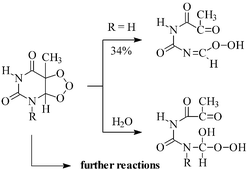The reactions of thymine and thymidine with ozone
Abstract
The ozonolysis of

* Corresponding authors
a
Max-Planck-Institut für Strahlenchemie, Stiftstr. 34-36, PO Box 101365, D-45413 Mülheim an der Ruhr, Germany
E-mail:
Clemens@vonSonntag.de
Fax: +49-208-306-3951
b Institut für Oberflächenmodifizierung (IOM), Permoserstr. 15, D-04303 Leipzig, Germany
The ozonolysis of

 Please wait while we load your content...
Something went wrong. Try again?
Please wait while we load your content...
Something went wrong. Try again?
R. Flyunt, J. A. Theruvathu, A. Leitzke and C. von Sonntag, J. Chem. Soc., Perkin Trans. 2, 2002, 1572 DOI: 10.1039/B204067K
To request permission to reproduce material from this article, please go to the Copyright Clearance Center request page.
If you are an author contributing to an RSC publication, you do not need to request permission provided correct acknowledgement is given.
If you are the author of this article, you do not need to request permission to reproduce figures and diagrams provided correct acknowledgement is given. If you want to reproduce the whole article in a third-party publication (excluding your thesis/dissertation for which permission is not required) please go to the Copyright Clearance Center request page.
Read more about how to correctly acknowledge RSC content.
 Fetching data from CrossRef.
Fetching data from CrossRef.
This may take some time to load.
Loading related content
